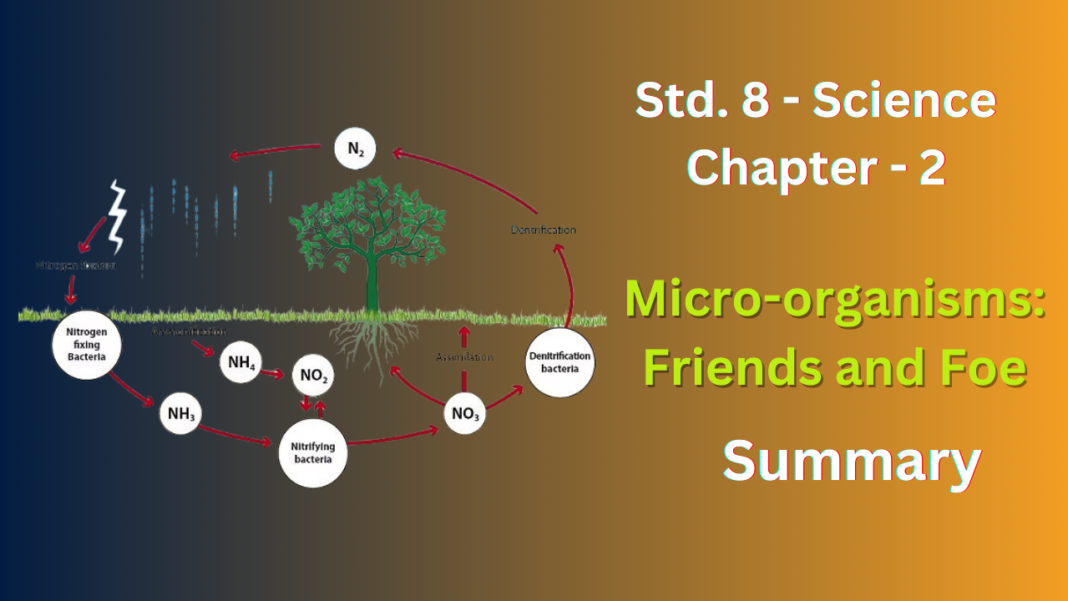NCERT Solutions for class 8 Science Chapter 2
Here are the summary of Microorganisms friend and foe:-
The chapter “Microorganisms Friend and Foe” talks about tiny living organisms that are too small to be seen with the naked eye. These are called microorganisms and come in various forms like bacteria, fungi, algae, and protozoa. They can live almost anywhere from freezing cold to boiling hot environments.
While some microorganisms are harmful and cause diseases like malaria and dysentery, others are beneficial and play an important role in our lives. Here’s a glimpse of what friendly microbes do:
- Food Production: They help in making delicious foods like bread, curd, cheese, and alcoholic beverages.
- Cleaning Up the Environment: They act as decomposers, breaking down dead plants and animals into simpler substances, thus cleaning up the environment.
- Soil Fertility Boosters: Some microbes fix nitrogen from the air and make it usable by plants, enriching the soil.
- Medicine Makers: These tiny friends help produce medicines like antibiotics and vaccines.
Overall, microorganisms are a double-edged sword. While some cause harm, others are essential for our health and the well-being of the planet.
NCERT Solutions for Class 8 Science Chapter 2 : Microorganisms Friend and Foe
Q1.Fill in the blanks.
(a) Microorganisms can be seen with the help of a _____
(b) Blue-green algae fix ______ directly from the air to enhance the fertility of soil.
(c) Alcohol is produced with the help of _____
(d)Cholera is caused by_
Ans:
(a) Microscope
(b) Nitrogen
(c) Yeast
(d) Bacteria
Q2. Tick the correct answer.
(a) Yeast is used in the production of
(i) sugar (ii) alcohol (iii) hydrochloric acid (iv) oxygen
Ans: (ii) Alcohol
(b) The following is an antibiotic:
(i) sodium bicarbonate
(ii) streptomycin
(iii) alcohol
(iv) yeast
Ans: (ii) streptomycin
(c) Carrier of malaria-causing protozoan is:
(i) female Anopheles mosquito
(ii) cockroach
(iii) housefly
(iv) butterfly
Ans: (i) female anopheles mosquito
(d) The most common carrier of communicable diseases is
(i) ant
(ii) dragonify
(iii) housefly
(iv) spider
Ans: (iii) housefly
(e) The bread or idli dough rises because of
(i) heat
(ii) grinding
(iii)growth of yeast cells
(iv) kneading
Ans: (iii) growth of yeast cell
(f) The process of conversion of sugar into alcohol is called
(i) nitrogen fixation
(ii) moulding
(iii) fermentation
(iv) infection
Ans: (iii) fermentation
Q3. Match the organisms in column A with their action in column B
| column A | Column B |
| (i) Bacteria | (a) Fixing nitrogen |
| (ii) Rhizobium | (b) Setting of curd |
| (iii) Lactobacillus | (c) Baking of bread |
| (iv) Yeast | (d) causing malaria |
| (v) A protozoan | (e) causing cholera |
| (vi) A virus | (f) Causing AIDS (g) production antibodies |
Ans:
(i) (e)
(ii) (a)
(iii) (b)
(iv) (C)
(v) (d)
(vi) (f)
Q4. Can microorganisms be seen with the naked eye? If not, how can they be seen?
Ans: No, microorganisms cannot be seen with the naked eye. They are microscopic in nature, which is why they are called microorganisms. The word “micro” means very small.
Since they are so tiny, we need special tools to observe them. The most common tool used is a microscope. A microscope magnifies objects, allowing us to see details that would be invisible to our unaided vision.
Q5. What are the major groups of microorganisms?
Ans: The major microorganism groups are:
- Bacteria & Archaea: Single-celled, very small, with bacteria lacking a nucleus (prokaryotic).
- Fungi: Can be single-celled (yeast) or multicellular (moulds), break down dead organic matter.
- Algae: Mostly single-celled but can be multicellular (seaweed), many are photosynthetic.
- Protozoa: Single-celled with a nucleus (eukaryotic), some can cause diseases.
- Viruses: Even smaller than others, not quite living, can cause diseases.
Q6. Name the microorganisms which can fix atmospheric nitrogen in the soil.
Ans: Nitrogen-fixing microbes in soil:
- Free-living: Azotobacter, Clostridium, Bacillus (live on their own)
- Symbiotic: Rhizobium (lives in legume root nodules)
Q7. Write 10 lines on the usefulness of microorganisms in our lives.
Ans: Microbes like yeast make our bread rise and alcoholic drinks ferment.
- Bacteria in our gut aid digestion and keep us healthy.
- Certain fungi decompose dead matter, recycling nutrients in the environment.
- Microbes like Rhizobium fix nitrogen in the soil, enriching it for plants.
- We use microbes to produce antibiotics that fight harmful bacteria.
- Vaccines, protecting us from diseases, are made with the help of microbes.
- Microbes are used in food production, like yoghourt with Lactobacillus.
- Some algae are a superfood source of protein and vitamins.
- Microbes can clean up oil spills and other environmental pollutants.
- Scientists are exploring microbes for potential uses in biofuels and medicine.
Q8. Write a short paragraph on the harms caused by microorganisms.
Ans: Microorganisms aren’t always friendly. While some help us, others can cause disease. These harmful microbes, often bacteria or viruses, invade our bodies and disrupt normal functions. This can lead to illnesses like food poisoning, cholera, and the common cold. Additionally, some microbes spoil our food and can damage materials like clothing and leather.
Q9. What are antibiotics? What precautions must be taken while taking antibiotics?
Ans: Antibiotics are medications that fight bacterial infections. They work by either killing the bacteria or stopping their growth. Antibiotics are a powerful tool in modern medicine, but it’s important to use them wisely to maintain their effectiveness.
Here are some precautions to take while taking antibiotics:
- Only take them when prescribed by a doctor: Don’t take leftover antibiotics or use them for a viral infection like the common cold.
- Take the exact dose and complete the entire course: Even if you start feeling better, don’t stop taking them early. This can allow the bacteria to survive and become resistant to the antibiotic.
- Don’t share antibiotics with others: Each antibiotic is meant for a specific infection.
- Tell your doctor about any other medications you’re taking: Some medications can interact with antibiotics.
- Be aware of potential side effects: Some people experience mild side effects like nausea or diarrhoea. If you have any concerns, talk to your doctor.
NCERT Solutions for Class 8 Science Chapter 2
FAQ’s
What topics are covered in NCERT Solutions for Class 8 Science Chapter 2?
NCERT Solutions for Class 8 Science Chapter 2 Microorganisms Friend and Foe cover various aspects of microorganisms, including their role in nature, their benefits to humans, and their harmful effects.
How can microorganisms be considered both friends and foes?
Microorganisms serve as friends by aiding in processes like decomposition, nitrogen fixation, and fermentation. However, they can also be foes by causing diseases in plants, animals, and humans.
What are some examples of beneficial microorganisms mentioned in Microorganisms Friend and Foe?
Examples of beneficial microorganisms include nitrogen-fixing bacteria, which enrich the soil with essential nutrients, and yeast, which is used in baking and fermentation processes.
How do microorganisms cause diseases?
Microorganisms can cause diseases through infection, contamination of food and water, and production of toxins harmful to humans, animals, and plants.
What preventive measures can be taken to control harmful microorganisms?
Preventive measures include maintaining personal hygiene, proper sanitation practices, vaccination, pasteurization of food and drinks, and using disinfectants to clean surfaces.
How can NCERT Solutions for Class 8 Science Chapter 2 help understand microorganisms better?
By studying NCERT Solutions for Class 8 Science Chapter 2, students gain insights into the significance of microorganisms, their ecological roles, and their impact on health and the environment.
Can NCERT Solutions for Class 8 Science Chapter 2 assist in learning about disease prevention strategies?
Absolutely! NCERT Solutions for Class 8 Science Chapter 2 discuss preventive measures to control harmful microorganisms, aiding in understanding disease prevention and management.









